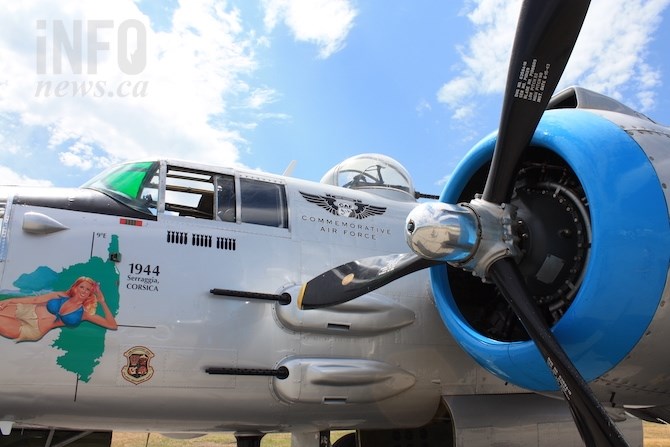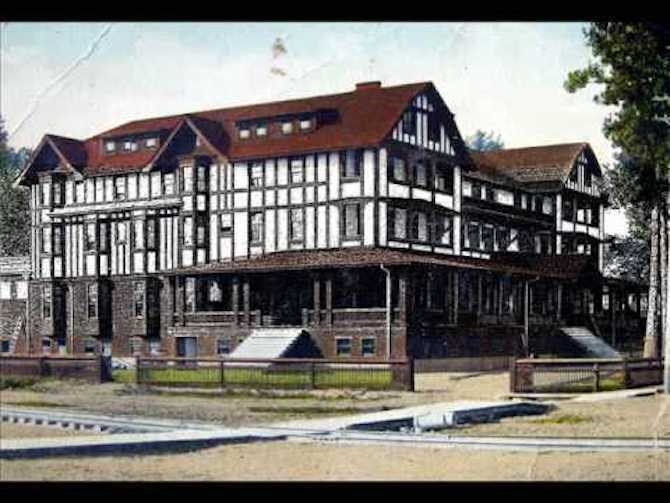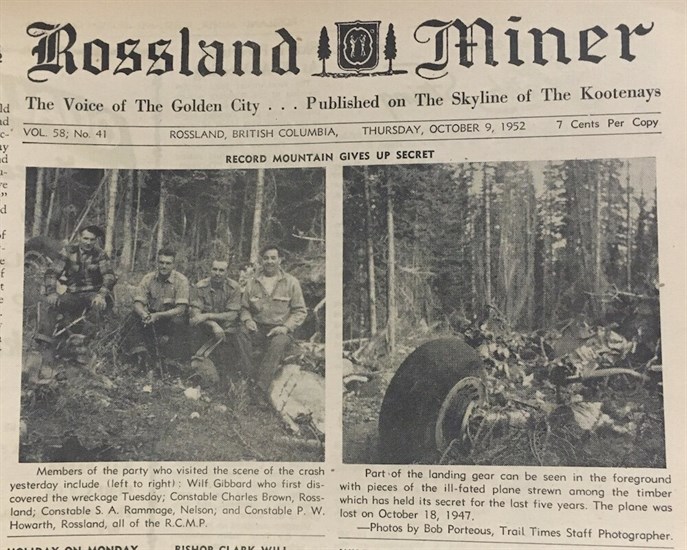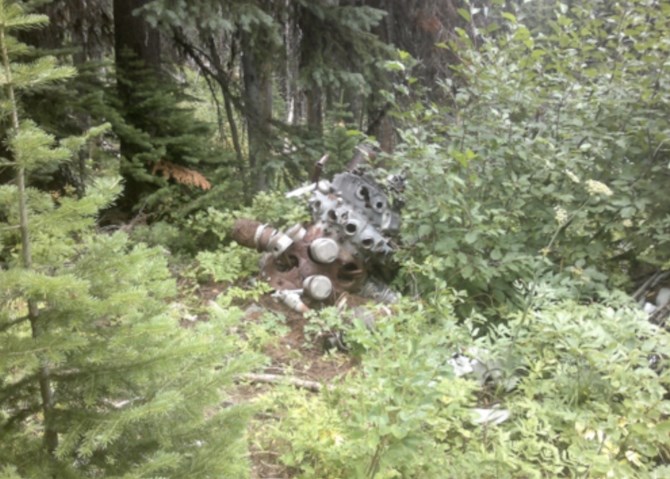
A Mitchell B-25 bomber, similar to doomed RCAF B-25 Mitchell 894 sits on the apron at Penticton Regional Airport in this June, 2017 photo. The aircraft had dangerous icing characteristics.
(STEVE ARSTAD / iNFOnews.ca)
March 14, 2021 - 8:00 AM
High on a mountainside near Rossland lies the wreckage of a Second World War bomber that met its end on an early winter October morning while on its way to Penticton.
The crash claimed the lives of two Penticton civilians and seven Royal Canadian Air Force servicemen who were familiar faces in the Peach City in the late 1940s.
The Mitchell aircraft crashed 13 miles northwest of Rossland in 1947. It made headlines in the Okanagan twice – when it disappeared from radio contact on Oct. 18, 1947, and again in Oct. 1952, when the plane’s wreckage was discovered by a Kootenay hunter.
The story of the doomed former bomber, which had been converted to photo-reconnaissance use by the RCAF, has resurfaced in recent years, with a recent story published in “Dispersals” magazine by David Poissant, and an article which can be viewed on the Rossland Museum and Discovery Centre's website.
The fateful tale began on Friday morning, Oct. 17, 1947.
Seven members of an RCAF photographic unit along with two well-known Penticton residents took off on a flight to Calgary that morning, leaving Penticton airport around 10 and arriving in Calgary at 11:37 a.m.
Inside were seven RCAF aircrew, Bliss Bowman, 24, Benjamin Cook, 28, Georges Lebel, 25, John MacLeod, 28, William Molyneux, 24, Arthur Robertson, 32, and James Sabourin, 25, as well as two Penticton civilians, Fred and Beulah Knight.
The Knights were managers of the old Incola Hotel, located at the site of where the three condominium towers at 100 Lakeshore Drive stand in Penticton today.
The Knights had three children – Beulah Jean, 8, Cecil Jane, 9, and Billy, 6.
READ MORE: Adventures in Penticton commercial air service
They did not accompany their parents.

The old CPR Incola Hotel on Lakeshore Drive.
Image Credit: SUBMITTED / YouTube
After spending the afternoon in Calgary, the crew took off at 4:01 p.m. to return to Penticton but the plane was forced back to Calgary due to poor weather.
Another attempt was made to fly back to Penticton the following day at 10:32 in the morning, with sufficient fuel for a six-hour flight.
According to David Poissant’s account of the crash in the“Dispersals” newsmagazine, the flight plan listed only the seven RCAF personnel, but witnesses said at a later inquiry into the crash that Fred and Beulah Knight were also on board the plane.
The last contact anyone ever had of the Mitchell B-25 was a request from the aircraft for a weather report out of Crescent Valley weather station near Creston, B.C., around 11:30 a.m. on Oct. 17, 1947.
The Crescent Valley radio operator never received a reply from the aircraft.
By Oct. 23, five days later, the Thursday edition of the Penticton Herald, (from the Penticton Museum Archives) read: “Bad weather hampers search for missing plane - Aircraft armada sweeping wide area.”
The search was massive by that point, with search planes flying as long as weather conditions permitted. Lowering skies and limited ceilings had dominated weather patterns since the plane had gone missing for all but one day.
The search involved aircraft from the United States Navy, Coast Guard and Air Force, as well as several local civilian planes.
Penticton pilots of the day who participated in the search included Carl Agar, Al Holden, Dave Filby and Dan MacIvor.
Kelowna pilots included Andy Duncan and Mr. and Mrs C.G. Renfrew.
The search involved 30,000 square miles of mountainous terrain in southern British Columbia.
The Herald reported, “every clue, every hint has been investigated, including reports from loggers and others of a plane flying low, but as of press time, searchers were no closer to the plane’s fate.”
The Herald reported one theory making the rounds was the plane, flying high over the clouds and bad weather, dropped down, and in doing so encountered icing conditions.
This would put the radio navigational aids out of commission and they "literally would not know where they were,” a search pilot suggested.
News of the lost plane hit Penticton hard. The Knight children were left parentless, while the Mitchell crew had been familiar faces in Penticton, where they had been based off and on for four years doing photographic reconnaissance.
According to research prepared by Ron Dennett for the Rossland Museum and Archives, eyewitnesses were on top of Red Mountain on the morning of Oct.18, 1947. The plane flew right over the top of two men who were clearing ski runs. They described the weather as snowing, with visibility around zero due to fog.
The plane sounded so close the two men hit the ground.
Minutes later, it is believed the plane, badly iced up and losing altitude, crashed into Plewman Basin, not far away.
No one heard the crash, however, because of the howling wind.
The search was called off after a month of intensive effort and five years went by.
READ MORE: "Season of miracles': How the South Okanagan mobilized to rescue plane crash survivors in 1950
In early October 1952, Mr. Wilf Gibbard caught sunlight glinting off a piece of aluminum high on Record Mountain, near Rossland, while out hunting.

The Rossland Miner newspaper announced the discovery of the downed Mitchell five years after it fell out of the sky.
Image Credit: SUBMITTED / Rossland Museum and Discovery Centre
He led a search party to the site where they found a compact debris field containing the bits and pieces of a badly mangled aircraft that was later identified as missing RCAF B-25 Mitchell 894.
David Poissant, in his “Dispersals” article, described the plane as badly demolished, indicating a terrific impact. Searchers had to dig into the mountain to unearth fragments of the plane and a few human bones, which were placed in a common grave nearby.
A cross was erected to mark the general location of the crash site.

The Mitchell was totally destroyed in the crash, indicating a totally uncontrolled impact at high speed.
Image Credit: SUBMITTED / Rossland Museum and Discovery Centre
An inquiry into the crash later in the year determined the Mitchell to have crashed around 11:35 the morning of Oct. 18, 1947, presumably due to heavy icing. Mr. and Mrs. Knight were identified after Fred’s wallet and a quantity of hair identified as Beulah’s was found in the wreckage.
During the inquiry, it was also noted few human remains were found at the site. It was postulated that a local grizzly bear population was most likely responsible for that.
A statement in the “Findings” section of the report read: "The cause behind the crash may well have been a desperate attempt by (First Officer Robertson) to get his passengers to Penticton rather than abort the flight."
The report also noted the Knights’ presence on the doomed flight was contrary to regulations but was probably intended as a sightseeing day trip to Calgary, as a goodwill gesture for their hospitality.

Ron Dennett took this photo of the aircraft's remains in August 2014.
Image Credit: SUBMITTED / Ron Dennett
In a fateful twist, RCAF wireless operator George Morrish turned out to be a lucky man, saved from being a part of the aircrew when a fellow crewman had a change of plans.
Morrish was part of another RCAF aircrew that was in Penticton at the same time as the doomed flight.
He was asked by officer F.B. Lebel to switch places on the flight so Lebel could return to Ottawa but at the last minute, he changed his mind, sparing Morrish and leaving Lebel to his fate.
READ MORE: Okanagan History - Soldiers trained on Okanagan Lake helped pave the way for Chinese rights in Canada

An engine from the downed Mitchell is slowly being consumed by the forest on Record Mountain, near Rossland.
Image Credit: SUBMITTED / Ron Dennett

The tail section of RCAF Mitchell 894.
Image Credit: SUBMITTED / Ron Dennett
To contact a reporter for this story, email Steve Arstad or call 250-488-3065 or email the editor. You can also submit photos, videos or news tips to tips@infonews.ca and be entered to win a monthly prize draw.
We welcome your comments and opinions on our stories but play nice. We won't censor or delete comments unless they contain off-topic statements or links, unnecessary vulgarity, false facts, spam or obviously fake profiles. If you have any concerns about what you see in comments, email the editor in the link above.
News from © iNFOnews, 2021